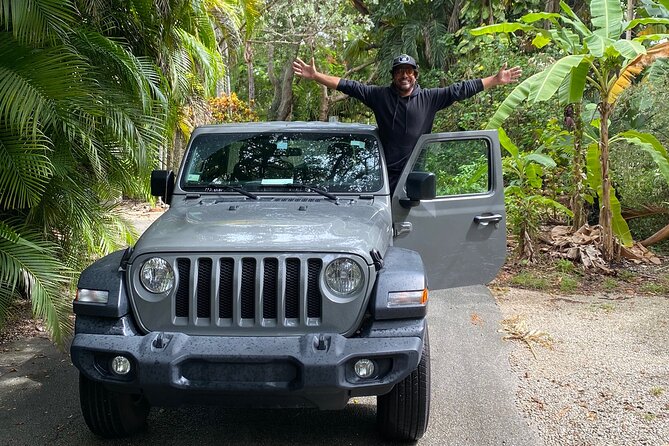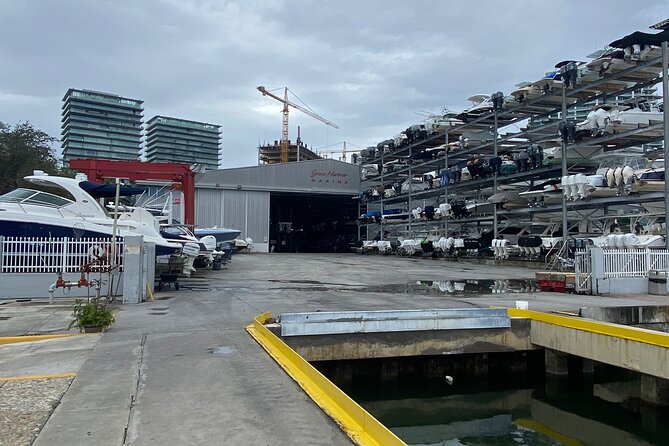With over 70% of all cocaine entering the United States passing through Miami in the 1980s, the city earned its title as the Cocaine Capital of the world.
Exploring the ‘Miami Cocaine Capital in the 80s – History Tour’ offers a unique opportunity to witness firsthand the gripping tales of power, wealth, and downfall that characterized this tumultuous era.
As participants traverse through the infamous locations and encounter the stories of key players, they will unravel the complex web of events that shaped Miami’s history forever.
Good To Know

- Miami was a hub of the global drug trade in the 1980s, fueling economic growth through illicit drug money.
- Notable locations and figures like Mutiny Hotel and Pablo Escobar shaped Miami’s dark legacy.
- Cocaine reshaped Miami society, leading to economic disparities, addiction rates, and health issues.
- Law enforcement faced unprecedented challenges combating sophisticated drug networks and internal corruption.
Historical Background of Miami in the 1980s

In the tumultuous 1980s, Miami emerged as a pivotal hub in the global drug trade, shaping the city’s identity and history in unprecedented ways. This era saw Miami experience an economic boom driven by the influx of illicit drug money, leading to rapid development and a surge in luxury real estate.
The cultural shifts were palpable, with the city gaining a reputation for excess and hedonism. The drug trade not only brought wealth but also violence and corruption, fundamentally altering the social fabric of Miami. As drug lords flaunted their riches, the city became a symbol of both glamour and danger, attracting attention from around the world.
The juxtaposition of prosperity and peril defined Miami during this tumultuous period.
Interested in history? More Miami historical sites we've covered
Notable Locations From the Cocaine Era

During the tumultuous 1980s, Miami’s landscape was transformed by the presence of key locations that played pivotal roles in the city’s notorious reputation as a cocaine capital. Architectural landmarks like the Mutiny Hotel, known for its luxurious setting frequented by drug lords and celebrities, stood as symbols of excess and illicit activities. Plus, cultural influences such as the vibrant nightlife scene at Club Deuce reflected the hedonistic lifestyle associated with the drug trade. Another notable location was the Fontainebleau Hotel, which served as a backdrop for high-stakes deals and extravagant parties. These sites not only shaped Miami’s physical appearance but also left a lasting impact on its cultural fabric during this turbulent era.
| Architectural Landmarks | Cultural Influences | Notable Locations |
|---|---|---|
| Mutiny Hotel | Club Deuce | Fontainebleau Hotel |
Key Figures in Miami’s Drug Trade
Amidst the glamorous facade of Miami’s architectural landmarks and vibrant cultural scenes during the cocaine era, key figures emerged as influential players in the city’s notorious drug trade. Drug lord profiles like Griselda Blanco, known as the ‘Black Widow,’ and Pablo Escobar, the infamous head of the Medellín Cartel, dominated headlines with their criminal enterprises.
Blanco’s ruthless tactics and Escobar’s strategic alliances shaped Miami’s underworld, fueling a wave of violence and corruption. Plus, figures such as Carlos Lehder, a co-founder of the Medellín Cartel, and Willy Falcon and Sal Magluta, who ran a massive smuggling operation, further solidified Miami’s reputation as a hub for drug trafficking.
These individuals left a lasting impact on the city’s history, contributing to its dark legacy as a cocaine capital.
Impact of Cocaine on Society
Cocaine’s pervasive influence on Miami’s social fabric during the 1980s reshaped community dynamics and law enforcement strategies. The drug’s arrival brought about significant social implications, leading to a cultural change that reverberated across the city.
Miami witnessed economic effects as the drug trade boomed, creating disparities and altering the city’s financial landscape. On top of that, the public health sector faced unprecedented challenges with the rise in addiction rates and associated health issues.
The prevalence of cocaine in Miami not only affected individuals but also transformed the overall societal structure. This era marked a critical juncture in Miami’s history, where the impact of cocaine on society was deeply entrenched, leaving lasting consequences that would shape the city’s future.
Law Enforcement Efforts and Challenges
The rampant spread of cocaine in Miami during the 1980s presented law enforcement with unprecedented challenges and necessitated innovative strategies to combat the escalating drug trade.
Law enforcement efforts involved a variety of policing strategies to tackle the drug cartels effectively. Undercover operations played a crucial role in gathering intelligence and evidence against key players in the cocaine trade.
Corruption within law enforcement agencies posed a significant obstacle to the prosecution of drug traffickers. To overcome these challenges, specialized task forces were created to target specific aspects of the drug trade.
Continuous adaptation of tactics was essential to stay ahead of the sophisticated drug networks operating in Miami.
- Wynwood Graffiti Golf Cart Small-Group Tour
- A Taste of South Beach Food Tour
- 4 – 5 Hours Everglades Tour From Miami
- South Beach Cultural Food and Walking Tour
- Fully Private Speed Boat Tours, VIP-style Miami Speedboat Tour of Star Island!
- The Official Art Deco Walking Tour by The Miami Design Preservation League
Transformation of Miami Post-80s
Miami underwent a significant transformation in the aftermath of the 1980s, reshaping its identity and landscape in response to the challenges posed by its notorious past. Urban development became a focal point, leading to the revitalization of neighborhoods and the creation of new spaces for residents and visitors alike.
The city’s economic revitalization efforts also played a crucial role in shaping its post-80s era, attracting investments and diversifying its industries beyond the shadow of the drug trade. These changes not only helped Miami shed its reputation as a cocaine capital but also positioned it as a thriving hub for culture, tourism, and business, showcasing a resilient spirit that continues to drive its evolution.
Common Questions
Are There Any Age Restrictions for Participating in the Miami Cocaine Capital in the 80s – History Tour?
For the tour experience, age restrictions may apply. Visitors should check tour details for specific age requirements. It’s crucial to ensure all participants meet the necessary criteria before booking to fully enjoy the historical journey.
Can Participants Take Photos or Videos During the Tour?
Participants must adhere to tour etiquette by respecting photography rules. While capturing memories is encouraged, ensure it does not disrupt the experience for others. Follow guidelines provided by tour guides and refrain from taking photos in sensitive areas.
Is Food or Drinks Included in the Tour Price, or Should Participants Bring Their Own Snacks?
Food or drinks are not included in the tour price. Participants should bring their own snacks or consider picnic options. It’s recommended to inform the provider beforehand about any dietary restrictions for a smoother experience.
Are There Any Souvenirs or Merchandise Available for Purchase Related to the Tour?
Tour memorabilia and collectible merchandise related to the Miami Cocaine Capital in the 80s – History Tour are available for purchase. Participants can bring home souvenirs to remember the experience and explore Miami’s intriguing past.
How Far in Advance Should the Tour Be Booked to Secure a Spot?
To secure a spot on the Miami Cocaine Capital in the 80s – History Tour, guests should book ahead due to high demand. Booking requirements vary, so it’s advisable to check tour availability early for preferred dates.
The Sum Up
Step back in time and learn about the captivating history of Miami’s cocaine capital era with the ‘Miami Cocaine Capital in the 80s – History Tour.’
Explore the key locations, influential figures, and societal impacts that shaped this tumultuous period.
Gain a deeper understanding of Miami’s past, law enforcement efforts, and the transformation that followed.
Uncover the hidden truths and complex dynamics of this pivotal time in Miami’s history on this enlightening tour.
More Historical Tours in Miami
- Art Deco, History and Crime Bike Tour with Design Enthusiast
- Art Deco & History Walking Tour with Design Enthusiast
- Historic Highlights of Newport,RI with with the Gilded Age
- Jewish Sites Miami History Private Guided Walking Tour
- Miami Beach: South Beach Journey through Food and History
- Wynwood Food, Art, and History Tour: A Miami Culinary Experience
More Tours in Miami
- 45-Minute Miami Beach Sunset Breathtaking Flight Tour
- Amusing Private Boat Tour, Champagne, Sandbars, Floating Mat!!
- Classic Car Tour around Miami
- South Beach Art Deco Highlights and The Wolfsonian Museum Tour
- 90 Minute Small Group Semi Private Airboat Tour
- City Tour: Miami, Wynwood, and Little Habana + Cruise Tour
More Tour Reviews in Miami
Looking for something different? Other Miami activities we've written about
- 45-Minute Miami Beach Sunset Breathtaking Flight Tour
- 45 Ft Private Yacht Rental in Miami
- 3 Hours Polaris Slingshot Rental in Miami
- Miami Catamaran & Watersports: Jet Ski, Banana Boat & Drinks
- Amusing Private Boat Tour, Champagne, Sandbars, Floating Mat!!
- Biscayne Bay Island and Nature Exploration
- 37ft Private Captained Yacht Rental – Up to 13 Happy Guests
- Classic Car Tour around Miami
- Miami ATV Adventure- Free Passenger & Ski Mask
- South Beach Art Deco Highlights and The Wolfsonian Museum Tour
- ATV Riding in Miami- 2 for 1 price- ATV, farm fun, lunch and more
- 90 Minute Small Group Semi Private Airboat Tour
